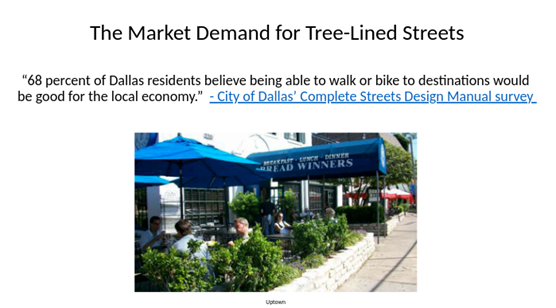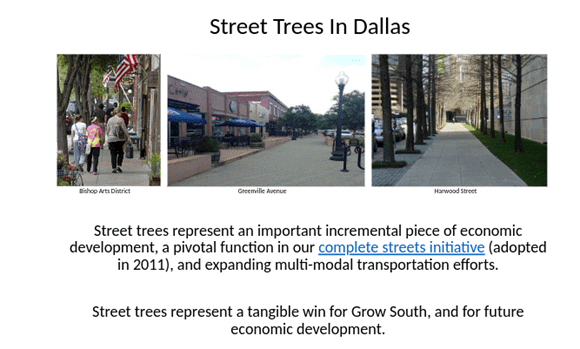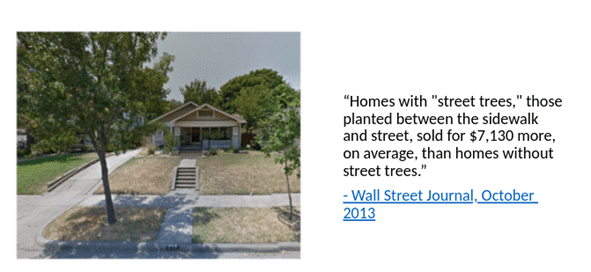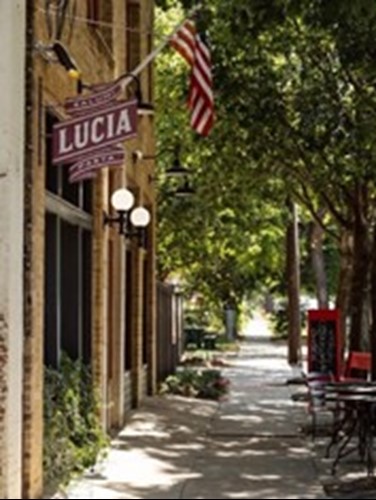Zoning Committee Member Ryan Behring Says Dallas Could Lure More Development with Urban Trees

One woman is trying to protect shade trees in Old East Dallas.

Published October 28, 2023, By APRIL TOWERY
When working on a story recently about a woman in Old East Dallas who wants to protect the shade trees in her neighborhood, I reached out to Zoning Ordinance Advisory Committee member Ryan Behring.
Behring isn’t your typical “tree hugger.” While he recognizes the environmental benefits of trees, he also heavily acknowledges their economic value. That’s why, since 2016, he’s been encouraging City Hall to use its fledgling Urban Reforestation Program to launch a tree-planting initiative.
Behring’s comments on the importance of trees for housing and economic development didn’t make it into the story for which I’d planned them — but the topic is worthy of its own deep dive.
“Street trees should be near the top of the City of Dallas and private development priorities in urban development for the environmental and air quality, let alone the other benefits,” Behring told CandysDirt.com. “There is tons of research on how they enhance real estate value in addition to environmental benefits and quality of air, life, and shade.”
While the City of Dallas hasn’t made any moves lately to reignite the Urban Reforestation fund, the Dallas City Council voted Wednesday to designate 86 trees “historic,” meaning they can only be removed with City Council approval or due to a dangerous public safety issue.
Trees making the historic cut include the Big Spring bur oak, a grove of trees at Dealey Plaza, a grove of 35 post oak trees at Pioneer Plaza Park, a Cherokee Park tree at Dallas Heritage Village, a California Crossing Comanche Marker tree, and the Moore Park Big Tree Grove.
A Positive, Tangible Difference
While leading the GrowSouth AmeriCorps program from 2015-2017, Behring worked with then-Mayor Mike Rawlings to spark interest in the city’s reforestation program.

Mr. Ryan Behring
“We saw it as a way for neighborhood associations to come together to make a positive, tangible difference in their community — fall Saturday mornings with coffee, doughnuts, and the camaraderie of making a difference,” Behring said. “The reforestation program became a great bonding opportunity for neighborhood associations and something they could be proud of. In all our team planted around 150 trees.”
Now a managing partner at Re:Studio Architecture, Behring said GrowSouth was initiated as a marketing effort for southern Dallas.
“It was trying to identify investors who wanted to come to the southern part of the city,” he said. “We were kind of like the boots on the ground, the community liaisons between City Hall and southern Dallas neighborhoods.”
Through those efforts, Behring met city arborist Phil Erwin and members of the Urban Forest Advisory Committee, which oversees the reforestation program.




But the effort lost steam over the years.
“Dallas is always looking for the next big thing, a convention center project or the bullet train, things that are billions of dollars,” Behring said. “This comes up every election cycle, like, ‘What about the potholes?’ That’s where trees are really interesting to me because I think for a $500-a-tree investment, you can plant them, water them for three years, and after that, they’re pretty self-sufficient.”
Oak Cliff business owner David Spence and other community leaders have been championing street trees and planting them with funding from their own pockets for years, Behring pointed out. Developer Monte Anderson touts a philosophy of investing incrementally, doing a small thing consistently in a small area to produce results.
“They’re saying the same thing, that it improves real estate value,” Behring said.
Arborist Steve Houser, a former chair of the Urban Forest Advisory Committee, said Dallas can’t address climate change, the urban heat island, or poor air quality unless “we can get more trees in the ground and save more existing trees.”
“I am not sure the parkway plantings were ever formalized into an official program but it seems it should be,” Houser said. “We are currently lobbying to restore the Mowmentum [median planting program] funds which could help to pay for median irrigation systems.”

Bishop Arts District
So what’s needed to fully revitalize the reforestation effort?
Behring says a consistent, committed public-private coalition of leadership and a “water-tight” vision for maintenance (pun intended).
“The best method we have found is the bottom-up, people-powered buy-in of adjoining property owners,” he said. “All in, with consistent leadership, I believe the program would take $500 to $1,000 per tree to plant and maintain over the recommended initial three years.”
There already is about $5 million in the city’s reforestation fund, which Behring said hasn’t, to his knowledge, been touched in years. The effort should be focused in urban districts where concrete is abundant and water spigots or hydrants are accessible via private property, he said.
“With a $5 million investment already there, we could strategically plant between 5,000 and 10,000 trees,” Behring said.
Trees Lure Economic Development and Housing
Many of the older, most desirable neighborhoods in Dallas are lined with mature street trees, Behring said.

Behring’s GrowSouth presentation
“I live near Winnetka Heights in Oak Cliff, and often choose to walk those streets in part due to their shade, air quality, human scale of the street, and architectural character,” he said. “Generally, investments in quality of life will yield real estate value. Other desirable Dallas neighborhoods that have this quality are sprinkled throughout Old East Dallas, Uptown, and parts of North Dallas. Many of these neighborhoods have appreciated significantly in value over the last decade.”
Commercial districts that invest in street trees also tend to see a higher length of shopping time and money spent in the district, according to Behring’s research. A 2013 Wall Street Journal study showed that homes with street trees sold for $7,130 more on average than those without.
“Think of it as the reverse broken-window theory,” Behring said. “Invest in small, tangible-win programs consistently over time — that a community can participate in — and community pride will grow and blight will recede. If nothing else, we’ve made better neighbors of ourselves.”

Bishop Arts District
District 1, where Behring lives, does a good job of maintaining urban street trees. Winnetka Heights is “on the way” to many businesses and shops along the gridded street system of West Davis, Tyler Street, and Kings Highway, he said.
“As an architectural designer one of the things I look at is the scale of the right-of-way,” Behring said. “Mature street trees make our often large, inhumane streets feel smaller, making the walk and adjacent real estate more desirable.”
City planner and author Jeff Speck shares that an urban walk should have four key elements: be useful, safe, comfortable, and interesting.
“Mature street trees generally contribute to each of these,” Behring said.
Posted in Urban Living in Dallas
